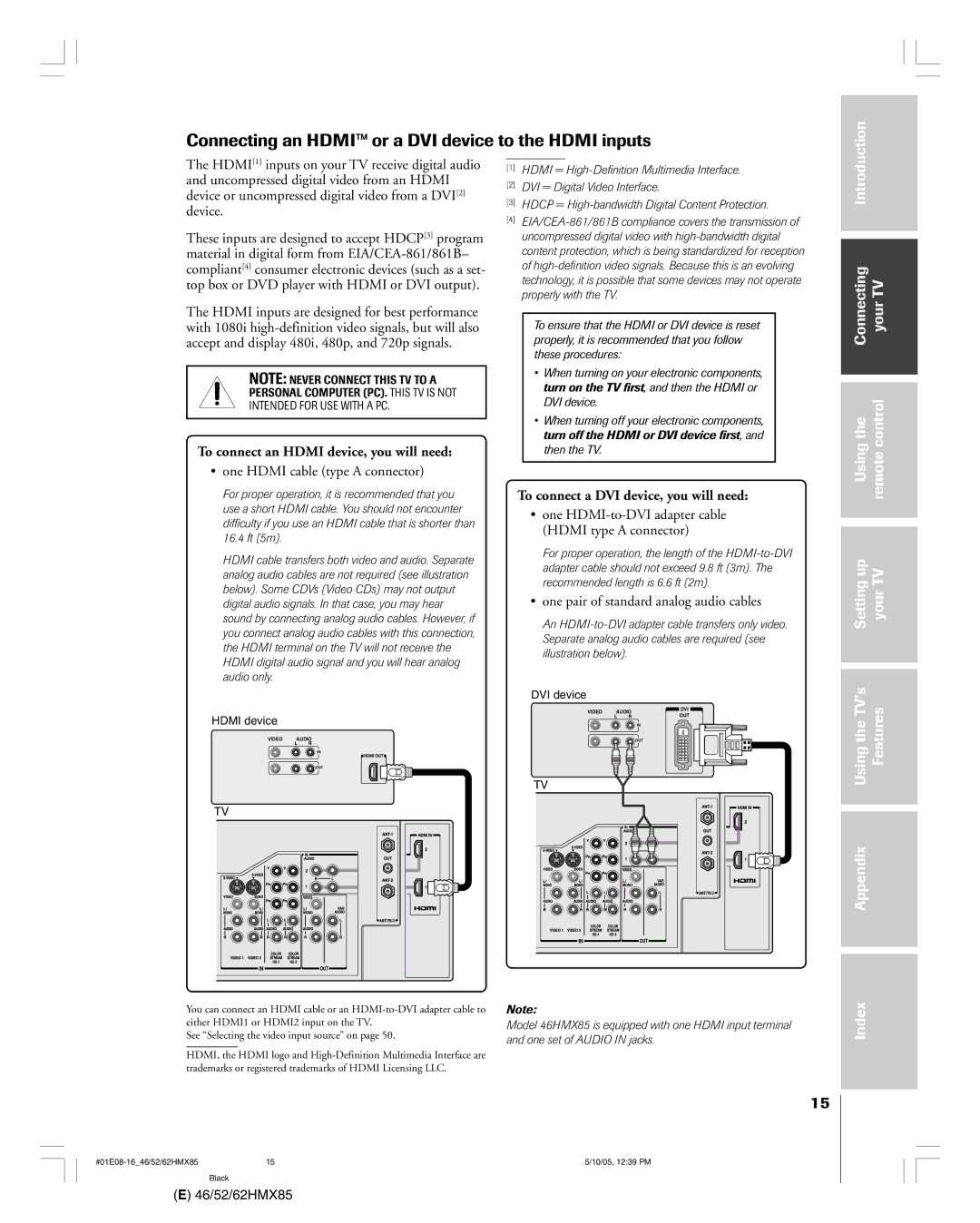Index
Dlptm Projection Television
Dear Customer
Lamp Unit Replacement
Installation
Important Safety Instructions
Care
Service
Important notes about your DLPª projection TV
Important Safety Information Introduction
Introduction
Welcome to Toshiba
Exploring your new TV
Connecting your TV
Connecting an antenna or cable TV
Connecting your TV
Connecting a cable converter box
Connecting a VCR
If you have a VCR with S-video, use an
Connecting a cable converter box and VCR
Satellite Dish
Connecting a DVD player or satellite receiver and a VCR
From Antenna Stereo VCR
From DTV Antenna
Connecting a camcorder
Connecting two VCRs
Connecting an HDMIª or a DVI device to the Hdmi inputs
¥ one Hdmi cable type a connector
¥ one pair of standard analog audio cables
Amplifier
Connecting an audio system
Using the remote control
Preparing the remote control for use
Installing the remote control batteries
Remote Control functional key chart
Using the remote control
CBL/SAT Audio VCR TV/VCR TV/SAT
Searching and sampling the code of a device
Device code setup
Introduction
Connecting YourTV
Usingthe Remotecontrol Setting up your TV
Using Appendix Index
Device code table
VCR setup codes
CD Player setup codes
Learning about the remote control
Learning about the menu system
Setting up your TV
Introduction Connecting your TV
Turning on the TV
Selecting the antenna input
Changing the on-screen display language
To program channels automatically
Introduction Connecting YourTV
Adding channels to the TVÕs memory
Programming channels automatically
Enter
Changing channels
Selecting the Quick Restart
Adding and erasing channels manually
Settingup yourTV
Using the TVÕs features
Adjusting the channel settings
Introduction Connecting YourTV Usingthe Control
Favorite CH
Press Enter to display
Favorite CH menu
Press Enter to erase the channel label
Labeling channels
Press z or y to highlight
Clear
Natural picture size
Selecting the picture size
¥ None of the picture is hidden
Usingthe Remotecontrol
Setting your
UsingtheTVÕs Features
¥ To lower the picture, press z
Press Enter to display the Scroll Adjustment mode
Scrolling the TheaterWide¨ picture TheaterWide 2 and 3 only
¥ To raise the picture, press y
Press y or z to highlight Auto ASPECT, and then press
Using the Auto Aspect feature
Usingthe Remotecontrol Settingup YourTV
UsingtheTVÕs Features Appendix Index
Will display in purple
Using the POP double-window feature
Press Split to display the POP window
Window Video 1, Video 2, Video 3, ColorStream HD1
Switching the speaker sound main or POP program
Swapping the main and POP pictures
Up TV
Double-Window aspect ratio
Using the programmed channel search function
Automatic favorite channel search feature
Using the favorite channel search function
If you cannot remember your PIN code
Using the Locks menu
Using the V-CHIP menu
Entering the PIN code
TV Rating Independent rating system for broadcasters
Enable Blocking
Mpaa Rating
Mpaa Rating Independent rating system for movies
Repeat steps 2 and 3 for other channels
UsingtheTVÕs Features Appendix
Locking channels
Unlocking programs temporarily
Press y or z to highlight Clear ALL, and then press Enter
NEW PIN Code
Locking the video inputs
Changing the PIN code
OFF
Adjusting the picture
Selecting the picture mode
Adjusting the picture quality
Setting YourTV UsingtheTVÕs Features
Selecting the color temperature
Introduction Connecting YourTV Usingthe Remotecontrol
Using the CableClear¨ DNR feature
Resetting your picture setting adjustments
Reset
Saving your new preferences
Film
Selecting the lamp mode
Selecting the cinema mode
Cinema Mode
To the previous menu, press y or z to highlight Custom
Press Enter to display the Video Label menu
Press y or z to highlight the video source you want to
Word Òvcró instead of Òvideo 1.Ó
¥ To view text, highlight T1, T2, T3, or T4
Using the closed caption feature
Closed caption feature has two options
Press y or z to highlight Caption or TEXT, Then press Enter
Setting the sleep timer
Setting the on timer
Using the TVÕs Appendix Index
Connecting YourTV Usingthe Remotecontrol
→ Normal → 1/2 Mute → Mute
Adjusting the sound
Muting the sound
Selecting stereo/SAP broadcasts
Press y or z to select the item, then press Enter
Using the WOWª surround sound feature
Adjusting the sound quality
Audio Settings menu appears
To turn off the Dolby Virtual surround sound feature
Enjoying the Dolby Virtual surround sound feature
Highlight OFF in above
Resetting your audio adjustments
Using the StableSound¨ feature
To turn off the StableSound feature Select OFF in above
Press y or z to select Main or POP, and then press Enter
Turning off the built-in speakers
Selecting the Audio OUT sound
To turn on the built-in speakers Select on in above
Displaying TV status information on-screen
Understanding the auto power off feature
Understanding the last mode memory feature
Selecting the background of the menu display
When to replace the lamp unit
Appendix Lamp unit replacement User-replaceable component
Using the remote control Setting up your TV Features
How to replace the lamp unit
Cleaning the lamp unit glass
Replace the thumb screw and hand-tighten
Lamp unit disposal
LED indications
VIDEO/AUDIO Input
Specifications
Troubleshooting
Help to reduce the effect of this phenomenon
Feature
Them of this issue
An attached gaming system, and video processing/different
Limited Canada Warranty
Audio OUT sound, selecting
Index
#01E70-7146/52/62HMX85 10/05, 1240 PM Black
46/52/62HMX85
Manufactured by

